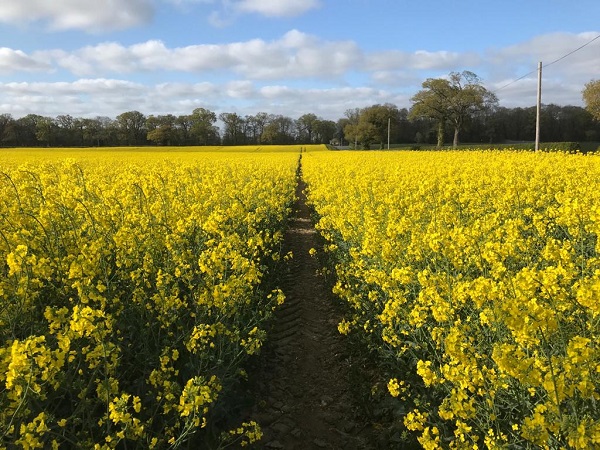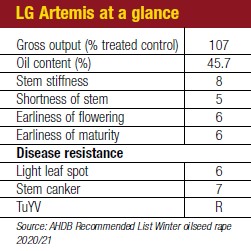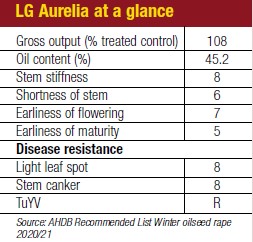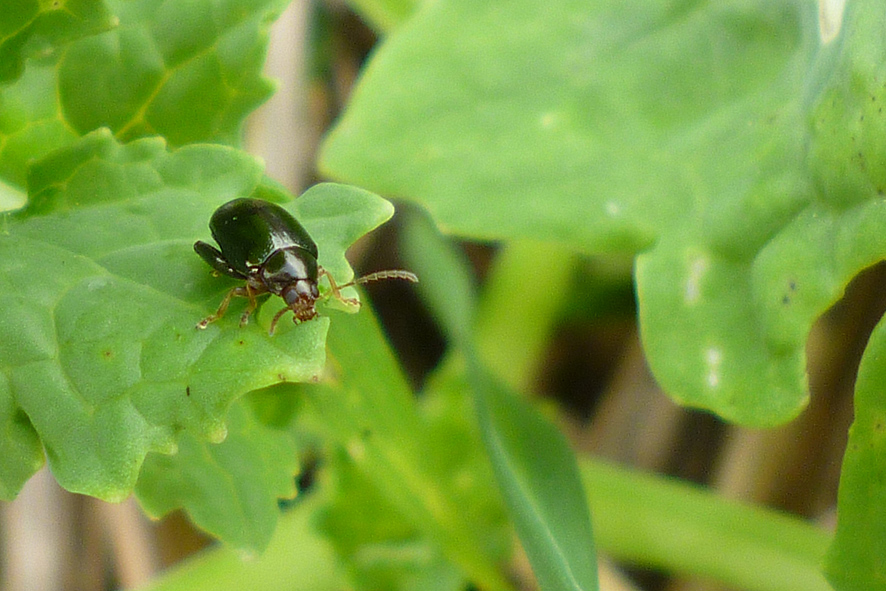Can plant genetics deliver to growers the tools required against cabbage stem flea beetle? CPM explores the progress made in pursuit of traits that offer crop resilience.
It’s an evolving character, but it’s already evident in some of our leading varieties through their vigour.
By Tom Allen-Stevens
It may be frustrating that growers no longer have the chemical solution to protect their crops from cabbage stem flea beetle. But the genetics are now stepping in to fill the void.
That’s according to Jonathan Tann, Limagrain business director for northern Europe, who says agriculture is moving to a new, more sustainable environment where genetics contribute a greater share of the value to integrated crop management. “Breeders have been working away quietly in the background for many years, laying down the foundations for this next stage of sustainable agriculture,” he says.

LG Artemis is an example of a variety offering a range of traits that bring credible resilience in a number of key areas.
“We’re now beginning to see the traits take over in providing the resilience crops need, allowing growers to rely less on chemistry. It’s not a change that’ll happen overnight, and genetics will only ever be part of a management toolbox growers bring into play. But oilseed rape is a good example, and Limagrain’s portfolio of varieties bring to the fore a range of traits that offer credible resilience in a number of key areas.”
It’s taken Limagrain about ten years to get here – back in 2010 it had just 0.1% share of the OSR seed market. But if you look at the 2020/21 AHDB Recommended List for winter oilseed rape, you’ll find the top six varieties with UK-wide approval have come from its pan-European breeding programme.
So how has the breeder achieved this? Dr Vasilis Gegas, LG’s European portfolio manager, puts it down to what he calls ‘precision breeding’. “It’s a process that never ends,” he explains.
“It starts around 10-20 years before a commercial variety actually reaches the market. You identify interesting material and gradually develop pieces of the jigsaw into genetic resources. Modern breeding techniques now allow us to precisely combine these into parent material, which become like cogs you slot into the machine of a hybrid breeding line.”
That gives the breeder the capacity in a global sense to address a problem, be that a physical limitation, such as pod shatter, a virus like TuYV, or indeed resilience against CSFB. But there’s still the process of screening to ensure it addresses the problem on a local basis in varieties that have all the key attributes needed for a particular geographic region.
Increasingly, some of this is done ‘in silico’, reveals Vasilis. “We use the genetic profile of a variety to run it through prediction models many times over. This gives you a very good idea of how it’ll behave and we therefore eliminate “no-hopers” before you’ve even put them in the ground. Breeders have used this tool for years, but we can now model the outcome of complex trait combinations and factor in how the environment would skew the outcome. It’s a very powerful way to target the local breeding programme.”
Varieties in UK breeding lines now offer growers a number of traits. One of the first was Rlm7, a gene introduced to confer resistance to phoma stem canker. “Pod shatter resistance is a trait we developed in parallel with other breeders and we now don’t have any new hybrids in commercial use that don’t have the trait.” Many varieties on the RL offer TuYV resistance, and LG has launched LG Ambassador – its first with N-Flex, that minimises yield loss in sub-optimal N conditions (see CPM, April issue).
“There’s not an easy answer to CSFB, however,” notes Vasilis. “We have been looking at various aspects of the pest and how it interacts with the crop. One of the limitations in this area has been the lack of specialised entomologists, and as a result we have very little understanding of the beetle itself. So it will take a long time before we have true genetic resistance.”
Much can be done through studying OSR establishment and breeding varieties that have resilience, however, and here there’s heaps of research. Niall Atkinson has been leading some of the work carried out by Agrovista at its Growcrop Gold trial sites across the UK. “Anything you can do to help the crop get up and away quickly will help against CSFB,” he says.
The latest trials at Draughton, near Agrovista’s heavy land site at Lamport in Northants, put a suite of strategies on test across 18 large 100x30m plots. On half of these the stubble was left long, and two different drills were used – a HeVa Evolution and a Weaving GD. Some plots were given a companion crop of berseem clover, now Agrovista’s favoured establishment partner for OSR, while Integral Pro (Bacillus amyloliquefaciens), Lumiposa (cyantraniliprole) and Hypro Duet (prochloraz+ thiram) seed dressings were all brought into play. Some plots were also given seedbed nutrition in the form of diammonium phosphate (DAP).
“Only some of the plots survived – they were about the only crops in that part of Northants that did,” reports Niall. “Preliminary observations show that every treatment was contributing a little bit to establishment success, and building in a number of these brings best results. Far and away the most important growth stages are in the very early establishment of the plant – the seedling must have vigour from the cotyledon through to 2-3 true leaves at least.”
This is the stage Vasilis and his team have focused on as they’ve screened varieties in UK LG trials. “Once the OSR plant has its first true leaves you know the root is working actively – that’s the crucial point and the plant has established in a way that can be sustained,” he says.
The ban on neonicotinoid seed dressings may have caused problems for UK growers, but it’s actually helped LG’s screening programme, he adds. “To have a natural field environment where the pressure exists consistently year on year allows us to carry out some very effective traditional screening. So we’re picking up varieties better equipped to withstand pest pressure, and it’s to do with, among other aspects, how they build biomass.”
It’s not only about the physical feeding, but about how the plant reacts to the attack at a physiological and metabolic level, he explains. “We’ve identified varieties that react differently, and this is the material we’re now bringing forward. It’s an evolving character with a lot of unknown aspects, but it’s already evident in some of our leading varieties through their vigour.
“Varieties like LG Aurelia and LG Artemis have very good capacity to establish fast and accumulate a high autumn biomass. For me, that capacity is more important than how it actually yields when it comes to getting crop performance when under CSFB pressure,” concludes Vasilis.
Artemis pledges protection against the OSR “gamble”
Professional OSR growers seeking the surest chance of success with their crop this autumn will be planting what Nigel Walley of Agrovista calls a “fully loaded hybrid”, which builds in all the best genetic innovations.
“They’ll look for pod-shatter resistance, TuYV resistance and Rlm7 phoma protection and they’ll be prepared to pay a premium for a hybrid that delivers these and more,” he says. “Previously some of these traits have been available in competitor hybrids, but LG has developed its UK breeding programme and has now struck a rich vein of both hybrid and open-pollinated material.
“LG Artemis fits the bill perfectly in this new landscape. It’s a fully loaded hybrid with all three traits in a high-yielding variety with strong disease scores, but what sets it ahead of the pack is its vigour. What we’ve found is that this variety establishes fast but doesn’t get too leggy, so it suits a wide range of sowing dates.”
Nigel advises Artemis for low to moderate CSFB situations. “Those facing apocalyptic CSFB would be well advised to avoid the crop altogether. Otherwise, we recommend using a seed dressing such as Integral Pro in combination with Lumiposa if deemed necessary. In all situations, the use of Tabor berseem clover as a companion crop has proved beneficial to establishment as part of an agronomic package designed to give the crop the best possible start.”
Nick Hood farms 320ha for Heath Farms, based at Woodbastwick, near Norwich and is growing 15ha of Artemis on his sandy loam soils on the advice of local Agrovista seed specialist Stuart Cree.
 “Growing OSR in the face of CSFB is turning into something of a gamble, so it’s the vigour we’re after,” he says. “Unless you get an even, fast establishment and good early growth, you’re struggling.”
“Growing OSR in the face of CSFB is turning into something of a gamble, so it’s the vigour we’re after,” he says. “Unless you get an even, fast establishment and good early growth, you’re struggling.”
Everything “fell together” for his crop, following winter and spring barley. Drilled on 19 Aug – a good 10-14 days earlier than his normal target date – this was specifically designed to “out-manoeuvre” CSFB. “We only have two fields in a rotation that puts OSR one year in seven among sugar beet, potatoes, winter and spring barley, wheat and temporary leys for our beef cattle,” says Nick.
“We plough and combi-drill with a Sulky Optiline. A key part of this is the system incorporates two presses – one on the front of the tractor and a Guttler closing ring press behind the drill – to conserve moisture. We didn’t put anything fancy on the seed, but did feed the seedbed 30kgN/ha with Nitroflo 20N + S.”
Pre-neonic yields would average 4.5-5t/ha, but Nick would be happy with 4-4.5t/ha these days and reckons his crop looks good for that. “It didn’t need any autumn fungicide with not a sign of light leaf spot. So far it’s had just a March dressing of Prosaro (prothioconazole+ tebuconazole). But it’s at establishment where the battle lies. Artemis was definitely growy, with good autumn vigour and it took off again in the spring,” he reports.
Golden promise from Aurelia’s vigour
“Vigaurelia” is how Beckii Gibbs of United Oilseed refers to the new Limagrain hybrid LG Aurelia. “It’s very vigorous. This has come through in independent trials and it has a high thousand seed weight, which also gives it an advantage at germination,” she says.
The variety is an exclusive for United Oilseeds, and that’s because it was the stand-out in trials, says Beckii. “It’s the vigour you notice, but Aurelia has a high gross output and oil yield, impressive disease scores of 8 for both LLS and phoma, TuYV and pod-shatter resistance.
“There was previously only one breeder who’d deliver varieties with these traits into the market, and you had to pick and choose which one you’d go for. Now you can get them all together, and anyone serious about growing OSR this autumn should consider putting in an LG variety.”
David Fuller would no doubt find himself in that category. As farm manager of McGregor Farms, based at Coldstream in The Scottish Borders, he’s responsible for 3400ha over 14 farms, nearly 800ha of which is in OSR this year.
“The key requirement for us is the vigour – 70% of our area goes in after wheat, which wasn’t even harvested until 20 Aug last year. Vigour is crucial in the autumn, but it’s also important in the spring,” he says.
 “Half of what we’re growing this year are Dekalb varieties, and the whole lot are hybrids. This is our first dabble with LG material – we’ve established 75ha of Aurelia because all the traits are there, along with its vigour. It also has a high oil content and its LLS score is a real draw.”
“Half of what we’re growing this year are Dekalb varieties, and the whole lot are hybrids. This is our first dabble with LG material – we’ve established 75ha of Aurelia because all the traits are there, along with its vigour. It also has a high oil content and its LLS score is a real draw.”
The variety also reputedly has a short, stiff structure with low branches that suit wide row-spacing. That fits with David’s establishment system – a 7m one-pass Simba SL with the seed popped behind the legs at 450mm centres that reach down 200-250mm. Firming up behind is an Aqueel roller that puts the soil surface into divots, serving both to conserve moisture and prevent surface run-off. A lowish seed rate of 35-40 seeds/m² is given a liquid feed of 27kg/ha P₂O₅ and 19kgN/ha.
“The Aurelia lived up to its promises in the autumn, establishing well. It’s been a testing winter for OSR, bit it did as well as any variety, and picked up well in the spring. Normally we’d apply a fungicide in Nov, followed by another with a PGR in March, but this crop didn’t need any treatment until a dose of tebuconazole with Amistar (azoxystrobin) at yellow bud.”
OSR has been pushed out to one year in six within the farms’ rotation and David’s always on the lookout for new varieties that’ll move the crop performance on – the five-year average yield is 4.7t/ha, while it achieved 4.9t/ha last year.
“Without a doubt it’s worth investing in the genetics. We’ll always give an interesting new line a try and then double the area if we like it. Aurelia ticks a lot of boxes, but the main one for us vigour. It’s delivered on its promises so far, so if this continues through to harvest, it can’t go wrong,” he says.
Inside traits
Sustainable agriculture is moving to a new era in which plant genetics play a greater role in the integrated crop management toolbox growers utilise to get the best from their crops. In this series, CPM has teamed up with Limagrain to give growers insight into these new tools. Through privileged access to staff and related research these articles look inside the traits, explore the genetics and unlock the secrets of a successful crop.
Limagrain started 50 years ago as a farmer-owned co-operative in France, and is now fourth largest seed company worldwide. With an annual turnover of nearly €1.9 billion, 16% of this is spent on R&D. By developing varieties with higher yields, improved resource efficiency and reduced environmental impact, Limagrain is a major contributor to meeting agriculture’s sustainability goals. And this guides the company’s raison d’être: to cooperate for the advancement of agriculture everywhere, for everyone.




